One way to date Knox College materials is through which Knox Seal was used in the design. The Knox Seal has long been used as a student symbol, not just an official symbol, and therefore is often the easiest way to date an object to a time range. The official story of the Knox Seal is a little murky, however. The most official writings about it come from the following two sources:
From the 1905 Gale, page 160.
It is not generally know that Knox has had three seals before the one which this year for the first time is stamped on the diplomas of the graduating class. Perhaps few have known that the Alumni pin adopted several years ago, and a likeness of the seal on the on the opposite page, has not been representative of the official seal of Knox until the year; but such are the facts.
 The first seal of which a record can be found is that of “Knox Manual Labor College.” In the records of the Executive Committee under date of March 7, 1838, is found this entry, “Resolved, that the seal hereunto affixed be adopted by this board as their corporate seal. N. H. Losey, Clerk.”
The first seal of which a record can be found is that of “Knox Manual Labor College.” In the records of the Executive Committee under date of March 7, 1838, is found this entry, “Resolved, that the seal hereunto affixed be adopted by this board as their corporate seal. N. H. Losey, Clerk.”
 About 1857, when Knox abandoned the title “Knox Manual Labor College” for a name at once more appropriate and more convenient, seal number two was adopted. On it were the words, “Knox College, Galesburg, Ill.” In the outer circle, and the open book of the first seal was retained.
About 1857, when Knox abandoned the title “Knox Manual Labor College” for a name at once more appropriate and more convenient, seal number two was adopted. On it were the words, “Knox College, Galesburg, Ill.” In the outer circle, and the open book of the first seal was retained.
On March 3, 1887, it was voted, “that the Treasurer and Secretary be authorized to procure a new seal of the best quality … for the college. E. A. Bancroft, Secretary.” The reasons for this action are not explained.
 Upon suggestions made by Mr. Bancroft, Robert J. Finley, during his senior year, designed the third seal in which “Veritas” for the first time appeared as well as the lighted torch and the date of the college charter, “1837.” The outer wreath is of pine and the inner one of bay.
Upon suggestions made by Mr. Bancroft, Robert J. Finley, during his senior year, designed the third seal in which “Veritas” for the first time appeared as well as the lighted torch and the date of the college charter, “1837.” The outer wreath is of pine and the inner one of bay.
Although satisfactory in design, it was imperfectly set in the die, making the impressions indistinct, so after sixteen years of service, it was replaced; and on November 7, 1903, the design of John H. Finley, made while he was president of Knox, was adopted as the official seal of the college.
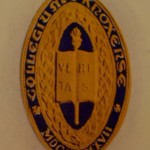 In this design, based on the prior seal, the shape is changed from round to oval and the outer wreath of pine is omitted. Roman numerals replace the Arabic in the date. [click image to enlarge]
In this design, based on the prior seal, the shape is changed from round to oval and the outer wreath of pine is omitted. Roman numerals replace the Arabic in the date. [click image to enlarge]
These seals are typical of the growth of Knox, symbolizing growth in art, broadening of refinement, enlargement of interests and usefulness. Pre-eminently characteristic of the prairie college in the past and, we trust not without meaning to he sons and daughters of the Knox to-day is the word implied in the first two seals and expressed in those which followed, “Veritas,” “Truth Inviolate.”
Added to this account from the Knox College Directory, 1963, page 414. under the title of, “Knox has had Four Official Seals”
 For two years the oval seal erroneously carried the words “Collegium Knoxensis.” Then they were corrected to “Collegium Knoxense.”
For two years the oval seal erroneously carried the words “Collegium Knoxensis.” Then they were corrected to “Collegium Knoxense.”
Omitted from the Knox Directory 1963 is the color picture from above.
Now, it does not take a math major to count to five, because there are five very distinct seals and only 4 accounts so far. The final transformation of the Seal occurred in 1937 at the hand of Ralph Fletcher Seymour for the Centennial Celebration of Knox College. The Seal was given an Art Deco flair, sharper corners, a more stylized Bay Leaf wreath and torch, as well as some additional changes. This is the current College Seal that is used to day.
There is at least one missing element to the story, however. The College Directory of 1963 added the sentence to the 1905 Gale story about the incorrect spelling, but the official seal printed in the Gale in 1904 (yes, the date on the cover of the Gale is 1905 but it was printed in 1904 by the Junior class of 1905) is clearly the correct and official version.
 The reason for the addition was that part about John H. Finley and the fact the seal was, “made while he was president of Knox.” As early as 11 August, 1898 John Finley was using in his official college letterhead, the seal he created. It was corrected at some point after this, but it was not made the Official College Seal for another 5 years. This image is off an official letter from the Office of the President and signed by John H. Finley.
The reason for the addition was that part about John H. Finley and the fact the seal was, “made while he was president of Knox.” As early as 11 August, 1898 John Finley was using in his official college letterhead, the seal he created. It was corrected at some point after this, but it was not made the Official College Seal for another 5 years. This image is off an official letter from the Office of the President and signed by John H. Finley.
This was the image that the students adopted for their college pin that is mentioned in the opening paragraph of the 1905 Gale history.
The symbols used in the College Seal are also interesting in and of themselves, and understanding them gives a much greater appreciation for the “suggestions made by Mr. Bancroft” to a college senior who was entrusted with creating the official image of the college.
Given that all students at Knox took either Greek or Latin or both at that time, their knowledge of the symbolism around the features of the Seal would be much stronger than our awareness today. In the original seal we had the open book representing scholarship and knowledge. Added in the Robert Finley Seal were bay leaves and pine boughs and three Pattée Crosses. The wreath of bay leaves are a symbol of the Greek god Apollo representing music and healing; the wreath of pine leaves are a heraldic symbol of eternal life; the torch can be a symbol of Life, Zealousness, Truth and Intelligence, and finally we have the Latin phrase Veritas for Truth Inviolate.
The suggestions made by Mr. Bancroft to John Finley were to add the torch (representing life and zealousness) in pursuit of the bay leaves (music, healing) and pine boughs (eternal life) and all of these images are focused on the pursuit of knowledge and Truth Inviolate.
By 1898, the new Robert Finley Seal was in use. Robert Finley took out the pine boughs but added in three Pattée Crosses. So in essence, Robert Finley took out one symbol of Christianity and eternal life and substituted a more obvious symbol. Since at this time in Knox’s history attendance at church services was still mandatory, having a clear expression of the denominational nature of the college would have been important to Robert Finley and the trustees. He also took the small torch and made it a central feature of the seal.
The last transformation came at Knox’s 100th birthday, after the college no longer required church service to graduate and after the cultural upheaval of the First World War and the Great Depression. Clearly, the Robert Finley seal did not represent the college any more, and Ralph Fletcher Seymour, an artist with deep connections to Knox, transformed the seal to fit the more modern times. He removed the three crosses but kept the symmetry with 5 bullets and used an Art Deco style to strengthen the remaining symbols.
I think I got off track in my setting up the timeline of the usage of the Knox Seal, didn’t I? Oops. Well, it is my site and my telling of the story, so I guess I can be forgiven. In everything above I have reliable sources to fall back on in my interpretation. In my opinion, I think the reason why John Finley elongated the Seal to the oval shape is because he was borrowing from the John Hopkins University Seal. Both Robert Finley and John Finley attended JHU after graduating from Knox. I have no sources or justification for that opinion, so I will add that here instead of up above. In the end, here is the dating structure:
 |
Original Knox Seal-March 7, 1838 to 1857
Designed by ? |
 |
Early College Seal-1857 to March 1887
Designed by ? |
![clip_image006[1] clip_image006[1]](https://knoxdocs.net/wp-content/uploads/2014/07/clip_image0061_thumb.jpg) |
Robert Finley Seal-March 1887 to November 7, 1903 (official use)
Designed by Robert J. Finley in his senior year at Knox |
 |
John H. Finley Seal-1898 to 1903 unofficially
November 7, 1903 to 1937 officially
Designed by John H. Finley, President of Knox College |
 |
Seymour Seal-1937 to present
Designed by Ralph Fletcher Seymour |
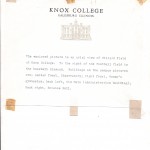 This is a 1960’s ish aerial photo of Knox. It is an official press release photo, as indicated by the official letterhead taped to the back describing it. The official description says it is of Willard Field (the first incarnation of Willard Field) but I saw something much more interesting in it.
This is a 1960’s ish aerial photo of Knox. It is an official press release photo, as indicated by the official letterhead taped to the back describing it. The official description says it is of Willard Field (the first incarnation of Willard Field) but I saw something much more interesting in it.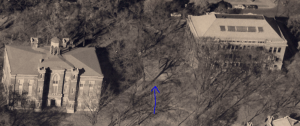 I even marked it with a blue arrow. See that little odd shaped foundation there? None of us who graduated in the 1980’s or 90’s ever saw that foundation. But on the right day in the Spring as the grass was growing, we could see an outline in the grass where it just didn’t grow as tall.
I even marked it with a blue arrow. See that little odd shaped foundation there? None of us who graduated in the 1980’s or 90’s ever saw that foundation. But on the right day in the Spring as the grass was growing, we could see an outline in the grass where it just didn’t grow as tall.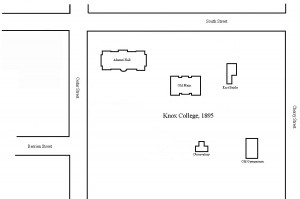

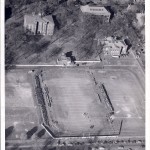

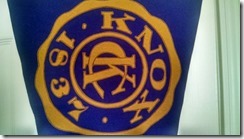
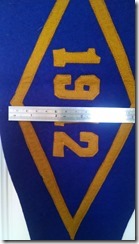
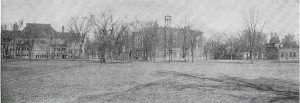








![clip_image006[1] clip_image006[1]](https://knoxdocs.net/wp-content/uploads/2014/07/clip_image0061_thumb.jpg)

